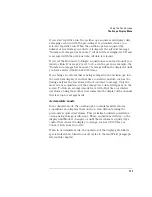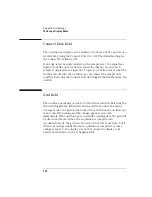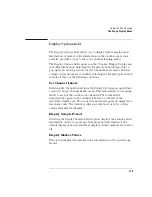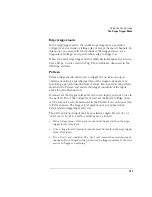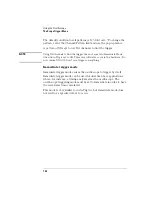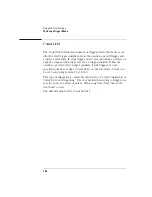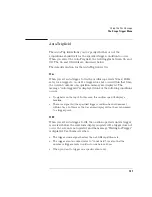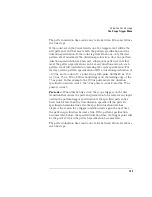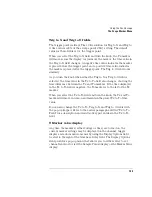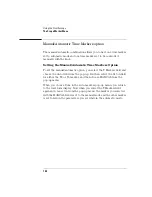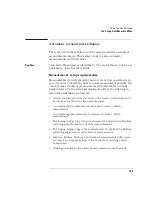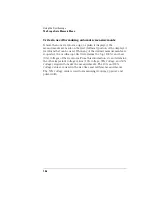
131
Using the Oscilloscope
The Scope Trigger Menu
If the count set in the Count field is one, the trigger event will be the
first pattern event that meets both the pattern specification and the
duration specification. If the count is greater than one, only the first
pattern event must meet the duration specification. Once the pattern
duration specification has been met, subsequent pattern events that
meet the pattern specification can be of any duration and each such
pattern event will contribute to meeting the count specification. For
instance, with a pattern specification of HX, a duration specification of
>60 ns & <100 ns, and a count of 3, a pulse string with pulse widths 200
ns, 80 ns, 150 ns, 50 ns, 75 ns, 20 ns would trigger on the trailing edge
of the 50ns pulse. In this example, the 80 ns pulse meets the duration
specification and is count 1, the 150 ns pulse is count 2, and the 50 ns
pulse is count 3.
Count field
In pattern trigger mode, you can define a pattern as a trigger qualifier.
When the oscilloscope detects the trigger qualifier, it will trigger when
the number of patterns specified in the Count field have occurred on all
inputs.
The Count field defines the number of events that must occur after the
first trigger qualifier before the oscilloscope will trigger and acquire a
waveform.
Count can be set to any integer from 1 to 32,000. The default value for
the Count field is 1.
Summary of Contents for 1670E Series
Page 6: ...6 In This Book...
Page 26: ...26 Contents...
Page 27: ...27 Section 1 Logic Analyzer...
Page 28: ...28...
Page 29: ...29 1 Logic Analyzer Overview...
Page 39: ...39 2 Connecting Peripherals...
Page 49: ...49 3 Using the Logic Analyzer...
Page 72: ...72 Using the Logic Analyzer The Inverse Assembler...
Page 73: ...73 4 Using the Trigger Menu...
Page 101: ...101 5 Using the Oscilloscope...
Page 151: ...151 6 Using the Pattern Generator...
Page 199: ...199 7 Triggering Examples...
Page 237: ...237 8 File Management...
Page 249: ...249 9 Logic Analyzer Reference...
Page 360: ...360 Logic Analyzer Reference The Compare Menu...
Page 361: ...361 10 System Performance Analysis SPA Software...
Page 397: ...397 11 Logic Analyzer Concepts...
Page 430: ...430 Logic Analyzer Concepts The Analyzer Hardware Oscilloscope board theory Oscilloscope board...
Page 439: ...439 12 Troubleshooting the Logic Analyzer...
Page 455: ...455 13 Specifications...
Page 471: ...471 14 Operator s Service...
Page 479: ...479 Operator s Service Troubleshooting Troubleshooting Flowchart 2...
Page 491: ...491 Section 2 LAN...
Page 492: ...492...
Page 493: ...493 15 Introducing the LAN Interface...
Page 497: ...497 16 Connecting and Configuring the LAN...
Page 506: ...506 Connecting and Configuring the LAN Connecting and Configuring the LAN...
Page 507: ...507 17 Accessing the Logic Analyzer File System Using the LAN...
Page 515: ...515 18 Using the LAN s X Window Interface...
Page 527: ...527 19 Retrieving and Restoring Data Using the LAN...
Page 539: ...539 20 Programming the Logic Analyzer Using the LAN...
Page 546: ...546 Programming the Logic Analyzer Using the LAN Programming the Logic Analyzer Using the LAN...
Page 547: ...547 21 LAN Concepts...
Page 555: ...555 22 Troubleshooting the LAN Connection...
Page 580: ...580 Troubleshooting the LAN Connection Getting Service Support...
Page 581: ...581 Section 3 Symbol Utility...
Page 582: ...582...
Page 583: ...583 23 Symbol Utility Introduction...
Page 588: ...588 Symbol Utility Introduction Symbol Utility Introduction...
Page 589: ...589 24 Getting Started with the Symbol Utility...
Page 597: ...597 25 Using the Symbol Utility...
Page 609: ...609 26 Symbol Utility Features and Functions...

